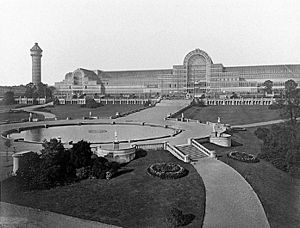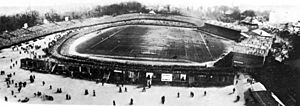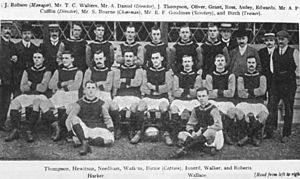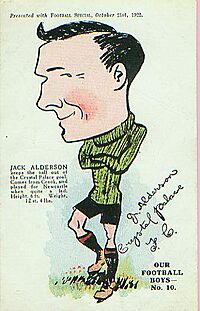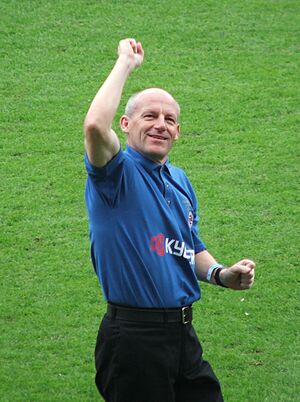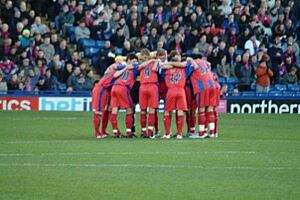History of Crystal Palace F.C. facts for kids
Crystal Palace Football Club is a professional football team from South London, England. The club was officially started in 1905 at the site of the famous Crystal Palace Exhibition building. However, its history goes back even further, to 1861, which is now shown on the club's badge.
Palace played their home games at the Crystal Palace grounds from 1905 until 1915. They had to leave because of the First World War. In 1924, they moved to their current home, Selhurst Park.
When the professional club began in 1905, Crystal Palace tried to join the Football League but wasn't accepted. Instead, they played in the Southern League Second Division. The club finally joined the Football League in 1920. Since then, they have mostly played in the top two divisions of English football.
Their best season in the top league was in 1990–91. They almost won the English league title, finishing third behind Arsenal and Liverpool. This is still their highest league finish ever. Palace missed out on playing in Europe that year because of a ban on English clubs that had just been lifted. This meant only one team could go to the UEFA Cup, and Liverpool got the spot.
Crystal Palace was one of the founding teams of the Premier League in 1992–93. However, they were relegated that same season, even though they earned 49 points. This is still a Premier League record for the most points a relegated team has ever had. Palace has also reached two FA Cup finals, in 1990 and 2016. They finished as runners-up both times, losing to Manchester United.
Contents
How it Started (1854–1905)
Between 1852 and 1854, a huge glass building called The Crystal Palace was moved from Hyde Park and rebuilt in South London, near Sydenham Hill. This area was then named Crystal Palace. The surrounding Crystal Palace Park was also created, where many sports facilities were built.
The company that owned the Crystal Palace building started the Crystal Palace Club in 1857 for cricket. Later, they decided to start a football team too. In 1861, they formed an amateur Crystal Palace football club. Many of its players were also part of the cricket team, and they played on the same pitch in Crystal Palace Park.
This amateur club was one of the first members of the Football Association in 1863. They played in the very first FA Cup competition in 1871–72, reaching the semi-finals. They played in the FA Cup for the next four seasons before the amateur club stopped playing in 1875.
In 1895, the Football Association found a new permanent place for the FA Cup final at the sports stadium inside the Palace grounds. The Crystal Palace Company wanted new attractions to bring in visitors. So, they decided to form a new professional football club to play at the stadium.
The professional Crystal Palace Football Club was officially formed on 10 September 1905. Sydney Bourne was the chairman, and Edmund Goodman helped set up the club. Goodman organized the business side and hired John Robson as the team's manager. Robson had a great record, turning his previous club, Middlesbrough, into a strong team. Goodman later managed Palace himself from 1907 to 1925, becoming the club's longest-serving manager.
Southern League Days (1905–1920)
The new professional club tried to join the Football League but was rejected. They had to start in the Southern League Second Division. To play more games, Palace also joined the United League, where they won their first professional match 3–0 against New Brompton. Manager John Robson built a team of sixteen professional players, mostly from the North East of England.
Palace's first season in the Southern League Second Division mostly involved playing against other clubs' reserve teams. Their first game was at home against Southampton Reserves, and about 3,000 fans watched. Palace led 3–0 early but lost 3–4. However, this was their only league defeat all season, and Palace became champions! They had a fantastic run of seventeen straight victories, including a 9–1 win over Grays United. Home crowds were usually between 2,000 and 3,000 fans.
After being promoted, Palace played in the Southern League First Division. They finished nineteenth but had a great run in the FA Cup. After winning a qualifying game, Palace faced Newcastle United in the first round. Newcastle was one of the biggest and most successful teams in England at the time. In a huge upset, Palace won 1–0 thanks to a goal from Horace Astley. They then beat Fulham and Brentford in replays to reach the quarter-finals. There, they played against the cup holders, Everton. In front of a record crowd of 35,000, Palace took the lead, but Everton equalized. In the replay, Everton won 4–0.
John Robson left Palace in 1907, and Edmund Goodman took over as manager. Palace had a good season, finishing fourth. Bill Davies became the first Palace player to play for his country, Wales. The next season, Palace struggled, finishing sixteenth. In the FA Cup, they lost 0–9 to Burnley, which is still the club's biggest defeat in that competition.
Palace finished seventh and then fourth in the following seasons, with crowds reaching 12,000. They also won the London Challenge Cup in 1913, beating West Ham United 1–0. In the 1913–14 season, Palace had a great run, finishing second in the league. They also won the London Challenge Cup again, beating Tottenham Hotspur 2–1. Defender Horace Colclough was even called up to play for England.
When the First World War started in August 1914, some Palace players were called up for duty. In March 1915, the club was told to leave the Crystal Palace grounds, so they moved to Herne Hill Velodrome. They finished that season in fifteenth place. After the war, Palace moved to a ground called The Nest, near Selhurst railway station. In the first full season after the war (1919–20), Palace finished third.
Joining the Football League (1920–1958)
Crystal Palace became a Football League club in 1920. The Southern League First Division teams, including Palace, joined together to form a new Football League Third Division. In their first Football League game, Palace lost 1–2 to Merthyr Town, with George Milligan scoring their first league goal. Their first home league game was a 0–0 draw against Plymouth Argyle.
However, Palace then went on a run of six wins in a row. Goalkeeper Jack Alderson kept five clean sheets during these wins. They only lost six more league games all season and were unbeaten in their final sixteen matches, including an eight-game winning streak. Palace won the championship by five points and were promoted to the Second Division! They only let in 34 goals all season, a record that stood until 1979. Palace became one of only a few clubs to win a championship in their first season in the league. They also won their third London Challenge Cup, beating Clapton Orient 1–0.
The next season, the Third Division was split into Northern and Southern sections. Palace was in the Second Division and finished fourteenth. In the FA Cup that season, Palace had one of their biggest wins, beating First Division Everton 6–0 away from home. In the 1922–23 and 1923–24 seasons, Palace finished sixteenth and fifteenth. Around this time, the club made an important decision to buy land for a new permanent home.
In 1922, the club bought a piece of wasteland at Selhurst for £2,750. Famous stadium architect Archibald Leitch was hired to design Selhurst Park. Construction was delayed, and when the ground opened on 30 August 1924, the main stand wasn't fully finished. However, it had many modern features like offices and training rooms. The first game at Selhurst Park was against The Wednesday, and 25,000 fans watched Palace lose 0–1. This defeat set the tone for the season, and Palace finished twenty-first, being relegated along with Coventry City. They lost their last game at home to Oldham Athletic, which would have kept them up. It would be almost 40 years before Palace played in the second tier again. Selhurst Park also hosted an England versus Wales international match in 1926, the only full international game played there.
After being relegated to the Third Division South, Edmund Goodman stepped down as manager in 1925 after 18 years. Several managers tried to get Palace back up the league. It was hard to get out of this division because only the champions were promoted. Palace came close many times, finishing runners-up three times before the Second World War. At the start of the 1939–40 season, Palace was second in the table, but the season was cancelled after only three matches because of the war.
During the war years (1939–45), football continued in special Wartime Leagues. Palace won the League South "D" Division in 1940 and then the South Regional League in 1941. The club used 186 different players during the seven wartime seasons.
After the war, Palace returned to the Third Division South. They had their worst season in 1948–49, finishing last and having to ask other clubs to vote for them to stay in the league. They kept their place and finished seventh the next season. However, they finished last again in 1950–51, scoring the fewest goals in a Third Division South season. Palace continued to struggle and needed re-election for a third time in 1955–56. They stayed in the bottom half of the division until the league was changed in 1958.
Climbing the Leagues (1958–1973)
The 1958–59 season brought big changes. Arthur Wait became the club chairman, and the league was restructured. Palace found themselves in the new Fourth Division. This division was formed by combining the bottom teams from the old Third Division North and South. Palace had not finished high enough to qualify for the new Third Division.
Palace finished seventh in their first Fourth Division season and eighth the next. In April 1960, Wait hired former Tottenham manager Arthur Rowe. The club then had a very successful 1960–61 season, finishing second behind Peterborough United and earning promotion to the Third Division. Palace also set Fourth Division records for the highest average attendance (19,092) and the highest attendance for a single match (37,774) against Millwall. Johnny Byrne scored 31 goals, and his teammate Roy Summersby scored 25.
Palace finished fifteenth in the Third Division in 1961–62. In November 1961, Johnny Byrne was called up to play for the England national team, even though he was playing outside the top two divisions. This was a rare achievement. He played in a 1–1 draw against Northern Ireland at Wembley Stadium. After this, West Ham paid a record fee of £65,000 to sign Byrne in March 1962. Byrne left Palace having scored 96 goals, a club record at the time.
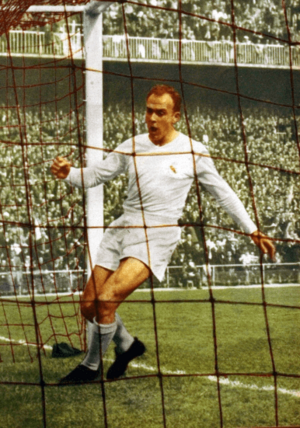
On 18 April 1962, Crystal Palace played a friendly match against the famous Real Madrid team at Selhurst Park. This game celebrated the opening of Palace's new floodlights. Real Madrid, who were about to play in the European Cup final, beat Palace 4–3 in an exciting match. Arthur Rowe resigned as manager in December 1962 due to health reasons, and former player Dick Graham took over. Palace finished eleventh in 1962–63, then gained promotion to the Second Division the following season, finishing second behind Coventry City.
Over the next few seasons, Palace finished in the top half of the Second Division. In April 1966, Bert Head became the new manager. Head brought in new players and promoted young players from the youth team, including bringing back Johnny Byrne. His hard work paid off in the 1968–69 season. Palace, who were not expected to be promoted, finished second behind Derby County. They earned a place in the top division for the first time in their history, securing promotion with a sixteen-game unbeaten run at the end of the season.
The song "Glad All Over" by The Dave Clark Five became a huge crowd favorite around this time. It was played regularly before home games, and Palace fans would bang on advertising boards to the beat. It is still the club's anthem today.
Palace's first season in the top division began with a home game against Manchester United. Mel Blyth scored the club's first ever First Division goal after eleven minutes, and a second goal from new signing Gerry Queen helped Palace draw 2–2 with United. The next match was a 2–0 home win against Sunderland. However, the season became a tough fight against relegation. Palace managed to stay up, finishing twentieth. They avoided relegation for two more seasons. The club also started a "Player of the Year" award in 1971–72, with defender John McCormick being the first winner.
Despite some good games in the 1972–73 season, including a 5–0 home win against Manchester United, Palace was relegated in their fourth season in the top flight. Arthur Wait, who had overseen the club's rise, was replaced as chairman by Raymond Bloye in November 1972. The club also appointed Malcolm Allison as the new manager in March 1973, replacing Bert Head. In Allison's first game, he gave a debut to young Scottish defender Jim Cannon. Cannon, who came through the youth ranks, scored the second goal in a 2–0 win against Chelsea, starting a long career with the club.
The Eagles Arrive (1973–1984)
Even though they were relegated, the 1973–74 season started with a lot of hope for Palace fans. Malcolm Allison, nicknamed 'Big Mal', was a famous coach known for his exciting personality. He changed the club's nickname from "The Glaziers" to "The Eagles." The club also changed its kit colors from claret and blue to red and dark blue, inspired by Barcelona. An eagle was introduced as the club mascot, and the club badge was redesigned.
The new season saw a new promotion and relegation system. Palace struggled in the Second Division, not winning any of their first fifteen league games. They were at the bottom for most of the season. With the help of talented winger Peter Taylor, they climbed to seventeenth place. However, they lost three games in a row and needed to win their final game at Cardiff City to stay in the second tier. They could only draw 1–1, and were relegated for a second season in a row.
The 1974–75 season saw Palace back in the Third Division for the first time since 1963–64. They missed out on promotion, finishing fifth. Allison signed Terry Venables and Ian Evans from QPR. Around this time, Allison also convinced the club to invest more in developing a strong youth team. This led to success at youth level and many promising young players joining the first team. Palace again failed to get promoted the next season, partly because of their FA Cup run. They reached the semi-finals, beating Leeds United and Chelsea, before losing 0–2 to Southampton. Allison resigned at the end of the season.
Allison was replaced as manager by Terry Venables, who had been his assistant. Venables guided the club to promotion in his first season. The Palace youngsters also won the FA Youth Cup with a team that included Kenny Sansom, Vince Hilaire and Billy Gilbert. They won it again the next season, becoming the first team to win the FA Youth Cup in a row since Chelsea in the early 1960s.
These talented young players became regular first-team players by the 1978–79 season. Palace was fighting for both promotion and the Second Division title. The final game of the season was at home to Burnley on 11 May 1979, in front of a record home crowd of 51,482. A win would make Palace champions. A draw would mean promotion but give the title to rivals Brighton. A defeat would mean Sunderland would get promoted instead of Palace. At half-time, it was 0–0. In the second half, a cross from Vince Hilaire allowed Ian Walsh to score the first goal. Then, a great run by David Swindlehurst ended with a goal from outside the box, giving the Eagles a 2–0 win. Palace were crowned champions and had reached the top flight again!
As more players from the FA Youth Cup-winning team joined the first team, the press called Palace the "Team of the Eighties." They started the 1979–80 season well, staying unbeaten longer than any other top-flight club. They even briefly went top of the entire Football League after beating Ipswich Town 4–1 in late September. Unfortunately, the young stars couldn't keep this form up, and Palace finished thirteenth, which was their highest league finish at that point.
The team's performance declined in the 1980–81 season, with nine defeats in the first ten games. Venables left Palace to join QPR. The club also faced financial problems. By January, they were almost relegated. Then, a big change happened: Ron Noades, who was chairman of Wimbledon, led a group to take control of the club. Palace spent the next couple of seasons fighting to avoid relegation from the second tier. There were many changes in managers, including the unpopular appointment of former Brighton manager Alan Mullery.
The Steve Coppell Years (1984–1993)
Former Manchester United and England player Steve Coppell became Crystal Palace's new manager for the 1984–85 season. Coppell's playing career ended early due to a knee injury. With help from former Palace player Ian Evans, he worked on rebuilding the club. He signed the unknown Ian Wright from a non-league team and Mark Bright from Leicester City. These two became a very successful attacking duo, known as "Wrighty & Brighty."
Coppell brought stability to the club in his first two seasons. After two more seasons of just missing out on the play-offs, they almost achieved automatic promotion by just one point. Instead, the club entered the 1989 Second Division play-offs. They beat Swindon in the semi-finals to set up a two-legged final against Blackburn Rovers. Blackburn won the first game 3–1. But in the second leg at Selhurst Park, in front of 30,000 fans, the Eagles won 3–0 after extra-time, ending their eight-year absence from the top flight! Ian Wright, who scored 24 league goals and 33 in all competitions that season, was voted player of the year by the fans.
Palace began their first top-flight season in almost a decade by re-signing former youth player Andy Gray from QPR for £500,000. In November 1989, the club made headlines by signing Bristol Rovers goalkeeper Nigel Martyn for £1 million, a record fee for a goalkeeper in Britain at the time. Palace's league form that season was mixed, and they finished fifteenth.
But it was in the FA Cup that Palace truly shined. After beating several lower division teams, Palace reached the semi-finals. They faced the same Liverpool team that had beaten them 9–0 in the league earlier that season. The game was played at Villa Park. Liverpool scored first to lead 1–0 at half-time. Palace came out strong in the second half, and Mark Bright equalized within a minute. Palace then went 2–1 up, but Liverpool scored two more goals to lead 3–2 late in the match. However, Andy Gray scored an equalizer with just two minutes left, sending the game into extra-time. Alan Pardew then scored the winner in a thrilling 4–3 victory! For the first time in their history, Palace had reached the FA Cup Final.
In their first ever appearance at Wembley Stadium, Palace faced Alex Ferguson's Manchester United. Gary O'Reilly scored first for Palace, but Bryan Robson and Mark Hughes put United 2–1 up. Ian Wright then equalized immediately after coming on as a substitute, taking the final into extra-time. Wright scored again early in extra-time to put Palace back in the lead. But Hughes scored his second goal late on for United, making it 3–3 and forcing a replay. In the replay, Palace wore a special yellow and black striped kit. United's Lee Martin scored the only goal, winning the Cup for the Red Devils.
The club built on the success of the previous season and even challenged for the English league title for most of the next season. They finished third behind champions Arsenal and runners-up Liverpool, achieving the club's highest league finish to date. Palace were unlucky not to get a place in Europe. The ban on English clubs after the Heysel Stadium disaster had been lifted, but England was unranked in European competitions. This meant only one spot was available in the UEFA Cup, and Liverpool got it instead of Palace. That season, Palace also made their third trip to Wembley in twelve months, winning the Full Members Cup by beating Everton 4–1 after extra-time in the final.
The following season (1991–92) was marked by some controversy. Chairman Ron Noades made comments that were seen as insensitive towards black players. Ian Wright left the club soon after, moving to Arsenal for £2.5 million. Palace finished tenth in the First Division.
In 1992–93, the top 22 clubs broke away to form the new FA Premier League, and Palace was one of the founding members. Mark Bright was sold to Sheffield Wednesday in September, and the Eagles struggled to score goals without him. They were relegated on goal difference on the last day of the season. Palace's 49 points that season was the highest total for any club relegated from the top flight of English football, and it remains a Premier League record. Coppell resigned after nine years, and his assistant Alan Smith took over.
Ups and Downs (1993–1998)
Alan Smith immediately guided Palace back to the Premier League as champions of the second tier. Striker Chris Armstrong was the top scorer with 23 league goals. During this time, the club badge was changed to feature an eagle that chairman Ron Noades felt looked more like a real eagle.
The next season back in the Premier League (1994–95) saw the club in the news for off-field reasons. On 25 January 1995, Palace played Manchester United at Selhurst Park. After a foul, United's French forward Eric Cantona was sent off. As Cantona walked off, a Palace fan taunted him, and Cantona reacted by kicking the fan. Manchester United suspended Cantona, and he was later given community service. The fan was banned from Selhurst Park. Palace reached the semi-finals of both domestic cups that season. However, a lack of goals and the introduction of a fourth relegation spot meant Palace were unluckily relegated on the last day again. The Premier League was being reduced from 22 to 20 clubs that season.
Smith left the club after Palace's relegation. Steve Coppell returned as technical director, with Ray Lewington managing the first team. In February, Dave Bassett joined as manager. He led the club to the 1996 First Division play-off final at Wembley, where they lost 1–2 to Leicester City in the final minute of extra-time. Bassett then left for Nottingham Forest in March 1997. Coppell took over as manager again, and the club reached the play-off final for the second year in a row. Palace won promotion back to the Premier League after beating Sheffield United 1–0, with David Hopkin scoring the winner in the 90th minute.
The 1997–98 season saw new faces on the board and on the pitch. Mark Goldberg joined the board and wanted to take over the club. Palace gained two Italian stars, Attilio Lombardo and Michele Padovano. Goldberg took control of the club in February 1998, with Palace at the bottom of the Premier League. Steve Coppell moved to Director of Football, and Lombardo became player-manager, with former Swedish international striker Tomas Brolin as his assistant. They couldn't improve the team's form, and Palace were relegated back to the second tier, finishing bottom with only two home wins all season. Lombardo and Brolin were replaced by outgoing chairman Noades and Ray Lewington for the last three games. Despite finishing bottom, Palace got their first taste of European football in the UEFA Intertoto Cup at the start of the next season. Goldberg's takeover was completed in June, but Noades kept ownership of the ground, leasing it back to the club.
Tough Times (1998–2010)
Palace's European adventure was short. They entered the UEFA Intertoto Cup in the Third Round and lost 0–4 on aggregate to Samsunspor of Turkey. Terry Venables returned for a second spell as head coach, but the dream of success quickly turned sour. Owner Mark Goldberg couldn't continue his financial support, and the club went into administration (meaning it was managed by experts to sort out its money problems). Venables left, and Steve Coppell returned to manage Palace again. Coppell guided the club to mid-table finishes.
In July 2000, Singapore financier Jerry Lim bought the almost bankrupt Crystal Palace. He immediately sold the club to millionaire businessman and lifelong fan Simon Jordan. Soon after taking control, Jordan replaced Coppell with Alan Smith, who returned for a second spell as manager. Despite reaching the League Cup semi-finals, Smith was sacked in April 2001, as relegation to the third tier seemed likely. Long-serving coach and former Palace player Steve Kember took temporary charge. Relegation was avoided on the last day of the season with an 87th-minute goal from Dougie Freedman away to Stockport County.
Palace then hired former Manchester United captain Steve Bruce as their new permanent manager for the 2001–02 season. After a good start, Bruce tried to leave the club after only four months to manage Birmingham City. Palace eventually allowed Bruce to join Birmingham and replaced him with Trevor Francis. After just two seasons, Francis was sacked, and Steve Kember was appointed manager permanently. Kember led Palace to three wins in their first three games of the 2003–04 season, putting them at the top of the table. But he was sacked in November after a bad run of results.
Kit Symons became caretaker player-manager, and the team's form improved. In December, Iain Dowie, a former Palace player, was appointed manager. Dowie transformed the club from relegation candidates at Christmas into play-off contenders by April. They reached the 2004 play-off final at the Millennium Stadium, beating West Ham United 1–0 with a goal from captain Neil Shipperley to return to the Premiership. The club couldn't stay in the top league again, despite 21 goals from Andrew Johnson. At that time, Palace had the unwanted record of being the only club to have been relegated from the Premier League four times.
The following season, the club reached the play-offs again but lost to Watford. Palace also lost another manager when Dowie left, saying he wanted to be closer to his family. Simon Jordan allowed Dowie to leave without paying a compensation fee. However, when Dowie joined local rivals Charlton Athletic, Jordan took him to court, settling the matter in 2008. Former Palace favorite Peter Taylor succeeded Dowie as manager for the 2006–07 season. Taylor was unsuccessful in getting the club promoted and was replaced by Neil Warnock two months into the next season. Warnock guided Palace to the 2008 Championship play-offs, where they lost in the semi-finals to Bristol City. The club finished fifteenth the next season.
The 2009–10 season began with the club facing financial difficulties. The Football League placed a transfer ban on Palace. The financial problems became very serious in January 2010, when the club went into administration. This meant a special team took over running the club. Star players like Victor Moses were sold, and manager Neil Warnock also left. Paul Hart was appointed caretaker manager. Before administration, the Eagles looked like they might reach the play-offs, but the club lost ten points because of the administration, turning the season into a fight against relegation. They only survived on the final day with a memorable 2–2 draw at Sheffield Wednesday, which sent Wednesday down instead of Palace. After the season, Dougie Freedman became temporary manager, and the club came out of administration, owned by a group of wealthy fans called CPFC 2010. The fans had campaigned to help secure the ownership of Selhurst Park for the club.
Back Among the Best (2010–Present)
The CPFC 2010 group, made up of businessmen Steve Parish, Martin Long, Stephen Browett, and Jeremy Hosking, appointed former Scotland boss George Burley as the club's new manager for the 2010–11 season, with Dougie Freedman as his assistant. Palace had few players, as many had left. One of Burley's first signings was former Netherlands midfielder Edgar Davids. The club didn't start the season well, and by November, they were at the bottom of the Championship table, and Davids left. Palace's away form was poor, and a 0–3 defeat at Millwall on New Year's Day led to Burley being sacked. Freedman was promoted to manager, and Lennie Lawrence joined as his assistant. They successfully guided Palace to safety with a game to spare.
Around the time of the managerial change, the club announced plans to move back to the site of the Crystal Palace National Sports Centre, their original home. They planned to redevelop it into a 40,000-seat football stadium. The following season started well, and by late October, the club was in third place in the league. Palace also had a good League Cup run, beating several teams to reach a quarter-final tie away at Manchester United. League form then slipped, and Palace went five games without a win or a goal before the United match. As underdogs, Palace won at Old Trafford for the first time in 22 years, thanks to a 35-yard strike from Darren Ambrose and an extra-time header from Glenn Murray. The club also announced plans for a new badge. On the pitch, league form remained inconsistent, and the League Cup semi-final ended in a penalty shoot-out defeat to Cardiff City. Palace finished the 2011–12 season in seventeenth place, an improvement on the previous season.
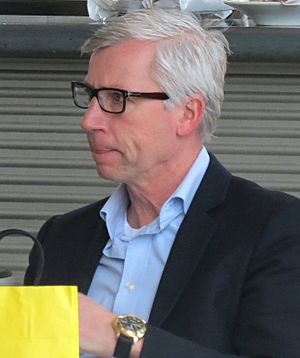
Freedman was in charge for a third season in 2012–13, Palace's eighth season in the Championship. He then left to manage Bolton Wanderers in October 2012. After short periods with Lennie Lawrence and Curtis Fleming as caretakers, former QPR manager Ian Holloway was appointed as the new permanent Palace manager in November. His first game was a 5–0 home win against Ipswich Town, which put the club at the top of the table. However, a poor run of results towards the end of the season meant Palace only just made it into the play-offs, finishing fifth. They played Brighton in the semi-final, winning 2–0 on aggregate after a 0–0 draw at Selhurst Park. Both goals in the second leg were scored by Wilfried Zaha. Palace then met Watford at Wembley in the final, winning 1–0 thanks to a Kevin Phillips penalty in extra-time. This secured a return to the Premier League for the Eagles after an eight-year absence!
In October of the 2013–14 season, Holloway quit as manager, with the club having only earned three points from their first eight Premier League games. He was replaced by former Stoke City manager Tony Pulis, who successfully guided the team to safety. Pulis then resigned just two days before the start of the 2014–15 season. Neil Warnock returned to Palace for a second spell as manager but was sacked in December 2014, with the club in the relegation zone. In January, former Palace player Alan Pardew was confirmed as the new manager. Under Pardew, the club won eight games out of twelve in the new year, securing mid-table safety and a third consecutive season in the Premier League.
The following season saw the club reach their first FA Cup Final in 26 years. Manchester United were the opponents, the same team Palace had lost to in the 1990 final. Palace suffered disappointment again, losing 1–2 after extra-time. Pardew was sacked in December 2016 after a poor run of results. The next day, Sam Allardyce was appointed as the new manager. Allardyce left the club two days after the end of the 2016–17 season for personal reasons.
On 26 June 2017, former Dutch international Frank de Boer signed a three-year deal to become the club's first ever permanent foreign manager. However, he was sacked after losing all of his first four league games. He was replaced by former England manager Roy Hodgson, who at 70 became the oldest appointee in Premier League history. Despite a very difficult start, the club eventually finished in a respectable eleventh place in the Premier League at the end of the 2017–18 season. This was followed by twelfth and fourteenth-place finishes in the next two seasons. After another fourteenth-place finish in the 2020–21 season, Hodgson left the club.
On 4 July 2021, Palace appointed former Arsenal legend Patrick Vieira as their new manager. Vieira led the club to a twelfth-place finish and an FA Cup semi-final in his first season. However, he was dismissed in March 2023 after a long winless run, which left the club in a relegation battle. On 21 March 2023, Roy Hodgson was re-appointed Palace manager until the end of the season. His experience helped guide the club to safety, finishing in eleventh place in the Premier League. Hodgson was appointed permanent manager for a second time at the start of the following season but stepped down in February 2024. On the same day, he was replaced by former Eintracht Frankfurt manager Oliver Glasner.


